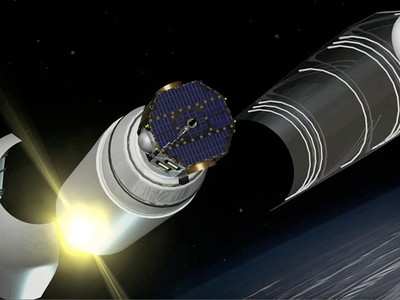Fri, Nov 14, 2008
SwRI-Led Team Begins Instrument Commissioning
Just over three weeks since
its October 19 launch, NASA's Interstellar
Boundary Explorer (IBEX) spacecraft -- the first mission designed
to image the interaction at the edge of the solar system --
concluded its orbit-raising phase and is beginning instrument
commissioning in preparation to start science observations.

After its launch to low Earth orbit (about 140 miles) onboard a
Pegasus rocket, the spacecraft used its own solid rocket motor and
hydrazine propulsion system to perform a series of burns that
ultimately raised its apogee (furthest point from Earth) to about
200,000 miles and its perigee (closest point) to about 8,000 miles
above the Earth — an orbit ideal for its science mission.
"Because the orbit goes so far out -- about five-sixths of the
way to the Moon -- it gets pushed around significantly by lunar
gravity and evolves over time in altitude and inclination," said
IBEX Principal Investigator Dr. David McComas, senior executive
director of the Space Science and Engineering Division at Southwest
Research Institute. "We're now in an orbit that provides excellent
science viewing and no long eclipses for at least the next two to
three years, without the need for additional burn maneuvers."
Before the science investigation begins, the IBEX team will
commission those spacecraft subsystems that weren't needed for the
orbit-raising period as well as the two IBEX science instruments.
During commissioning, the spacecraft spin rate will be reduced from
23 rpm to 4 rpm and pointed toward the Sun. At that point, the
remaining subsystems and instruments will be turned on and tuned to
ensure optimum mission performance.
When it begins its science observations in early December, IBEX
will use energetic neutral atom imaging to create the first-ever
all-sky maps of the interactions between the million mile-per-hour
solar wind blown out by the Sun and the low-density material
between the stars, known as the interstellar medium. The spacecraft
will complete an all-sky map of the interstellar boundaries every
six months.
IBEX is the latest in NASA's series of low-cost, rapidly
developed Small Explorers spacecraft. SwRI leads the IBEX mission
that includes a team of national and international partners. The
NASA Goddard Space Flight Center manages the Explorers Program for
the Science Mission Directorate in Washington.
More News
From 2023 (YouTube Edition): A Moniker Well-Chosen Founded in 2021 by serial entrepreneur David Mayman and headquartered in New York City, Mayman Aerospace is the designer and manu>[...]
The Controller Provided The Pilot With A Low Altitude Alert And The Altimeter Setting That Was Current At The Time On October 13, 2025, at about 0815 eastern daylight time, a Socat>[...]
Outer Marker A marker beacon at or near the glideslope intercept altitude of an ILS approach. It is keyed to transmit two dashes per second on a 400 Hz tone, which is received aura>[...]
Aero Linx: Seaplane Pilots Association The Seaplane Pilots Association is the only organization in the world solely focused on representing the interests of seaplane pilots, owners>[...]
“While business aviation is fully included in the FAA’s traffic reductions, we know that our sector will continue to pursue mandatory and voluntary means to ensure we a>[...]
 Classic Aero-TV: Mayman Aerospace Speeder Dazzles Oshkosh Crowds
Classic Aero-TV: Mayman Aerospace Speeder Dazzles Oshkosh Crowds NTSB Prelim: Socata TBM 700
NTSB Prelim: Socata TBM 700 ANN's Daily Aero-Term (11.11.25): Outer Marker
ANN's Daily Aero-Term (11.11.25): Outer Marker ANN's Daily Aero-Linx (11.11.25)
ANN's Daily Aero-Linx (11.11.25) Aero-News: Quote of the Day (11.11.25)
Aero-News: Quote of the Day (11.11.25)



